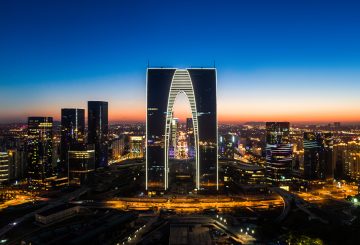
As you enter the workforce, it’s important to pay attention to the current – and future – economic and employment climate.
There is an adjustment that inevitably comes after university graduation as you prepare to enter the workforce. It’s an exciting time when you transition from a student to a professional, implementing the things you’ve spent a lifetime learning. It’s when all those hard skills – and soft skills – come to bear. To make this adjustment easier, it’s best to be prepared for the career you are entering, along with the general economic landscape and employment trends that exist in your planned job market and the major markets around the world. Which industries are thriving? Which are contracting? What’s on the horizon for your field? Do your skills match today’s needs and those of the future? Having a broad knowledge of today’s trends, and those forecasted, sets you up for long-term success and can guide your current and future job-seeking and graduate education approach.
Here is a snapshot of current employment trends in three major cities around the world.
Shanghai, China
Employment Outlook: China’s employers are expected to be cautious over the next 2 to 5 years because of the global economic situation. Most of them are not very optimistic. In the region, however, China is one of the countries with the strongest hiring intentions for this year. Shanghai plans to create around 600,000 new opportunities for skilled talents this year.
Industry Trends:
- Accounting and Finance: Fintech is revolutionizing financial services with the growth of e-commerce and non-traditional finance. China now boasts multiple fintech hubs including Shanghai. The city ranks as the third fintech hub worldwide in the latest Global Fintech Center Development Index, after New York and London. There are around 2,000 fintech companies in the city, which are leading in the use of emerging technologies such as cloud computing, AI and blockchain.
- Cleantech/Renewable Energy: Clean energy growth has seen record installations of both solar and wind energy plants in recent years. The government aims to reach a peak in carbon emissions by 2030 and at becoming carbon neutral by 2060. Huge investments have been made, creating the biggest solar market in the world with an installed solar energy capacity of over 886 GW. In Shanghai’s Chongming Island, the city’s renewable energy powerhouse, about one-third of electricity comes from green sources. The island uses photovoltaic and wind power.
- Engineering: Companies are investing more in R&D and technological advancements as they aim to enhance product quality by using new technologies such as smart manufacturing and robotics, green manufacturing and digital transformation. Shanghai boasts 561 foreign R&D centers, most of them focused on IT and new technologies such as AI, biomedicine, chemical industries and integrated circuits. High-tech industries significantly contribute to the city’s manufacturing output, though heavy industry still plays a key role in its economy.
Paris, France
Employment Outlook: Paris is ranked first in the EU as a startup ecosystem, and it is ranked fourth-best city worldwide for innovation, after Tokyo, London and New York. It is also ranked the first science and technology cluster in Europe and 12th worldwide.
The Paris administration offers plenty of job opportunities this year, including positions in the municipal police, hospitality and early childhood services. More specialist positions are also in high demand in Paris, including climate engineering technicians, doctors, data analysts, archaeologists, web developers, sales representatives and management controllers. In other communes in the Île-de-France region, industries looking for candidates include pharmaceutical logistics, cable manufacturing and aerospace.
With its high concentration of qualified workers and company headquarters, the capital offers the highest salaries in the country.
Industry Trends:
- Aeronautics: The country’s aeronautics industry dates to 1908 and is a key industry, with famous companies such as Airbus, Dassault and Safran. The region is a major aeronautics hub. The Centre National d’Études Spatiales (the National Center for Space Studies) is located here. As the most important aeronautics region in the country, the Paris region offers plenty of job opportunities.
- Business Management and Marketing: Paris is a major economic center. Paris La Defense is the fourth-largest business district in the world and hosts Europe’s largest concentration of Fortune 500 companies including AXA (insurance), BNP Paribas, EDF (Électricité de France), and telecom giant Orange. In addition, it is a major center of commerce and home to a vibrant startup scene. It is also a cluster of SMEs and home to 34% of French managers. The hiring outlook is positive, although the market is increasingly becoming more demanding, moving towards a hyper-specialization of sales professionals. As a result, companies might start offering attractive salaries, career advancement prospects, training opportunities, a positive company culture and other benefits to attract highly skilled professionals.
- Health Care: The Paris region is a major health innovation hub, with an above-average R&D spending related to GDP. It houses around 40% of France’s R&D researchers and is a leader in developing and implementing high-quality biomedical research. Paris, and France in general, is facing a shortage of health care staff. Many hospitals are overstretched. One-third of vacant positions are specialized care roles. Nurses and care assistants are also in severe shortages in almost all hospitals departments, especially in operating theatres, emergency rooms and nursing homes. Due in part to an aging population, physiotherapists are also in high demand.
Toronto, Canada
Employment Outlook: The sectors that appear to be weathering the current economic headwinds best are finance and insurance; health care; business services; scientific and technical; and the creative industries. The education and public administration sector is one of the few still actively hiring, having added 30,000 jobs over the past year. Job prospects for teachers and administrators at all levels remain good, according to Employment and Social Development Canada.
Industry Trends:
- Film and TV: Toronto’s television and film industry is one of North America’s largest. Ontario accounts for over a third of total film and TV production in Canada. The film sector is comprised not only of TV and film productions but also commercials, music videos, animation and special effects. Local specialties include post-production work, special effects, animation and emerging technology. The creative sector, which includes TV and film, was one of the few that added new jobs over the past year; employment increased by 5.3%. However, job postings over the last 12 months have declined by over 50%. Some shortage occupations include production accountants, set designers, costumers, grips, artists, VFX (visual effects) designers and sound mixers.
- Info/Communications Technology: The Toronto-Waterloo Corridor is the fourth-largest tech cluster in North America. It hosts over 15,000 companies and more than 5,200 startups and represents the main hub for Canada’s fintech ecosystem. More than 36% of the population in the corridor are foreign born, indicating a diverse and international workforce. Over the past five years, Toronto’s tech workforce has grown by 44%. Area strengths include interactive digital media and immersive technologies such as web3, virtual reality (VR), extended reality (XR) and the metaverse. The region is also a center for AI and quantum computing. The Toronto Intelligent Systems Lab, the NVIDIA AI Lab, the Samsung AI Center and the Sanofi AI Centre of Excellence are all based here.
- Manufacturing: Manufacturing is a major employer here, representing nearly 11% of all jobs in the metro region. Main subsectors include aerospace, food and beverage processing, medical devices, pharmaceuticals, robotics, e-mobility and EV (electric vehicle) charging. This increasingly high-tech industry relies on technologies such as artificial intelligence (AI), robotics, system integration, automation, sensors and machine vision. Although the current economic uncertainty has affected all industries, the manufacturing sector has been one of the hardest hit. The number of sector job postings over the past year declined by 82%. Nevertheless, job prospects remain good for manufacturing managers and supervisors, industrial and power electricians, and power engineers and power systems operators. Skills shortages are also growing as the population ages.
Research Smarter with GoinGlobal
Look for vetted, reliable information and resources on China, France, and Canada in GoinGlobal’s expert written Country & City Guides.
Access to GoinGlobal’s career and employment resource database is provided through subscribing institutions. Contact your college/university’s career center or library for access instructions.



